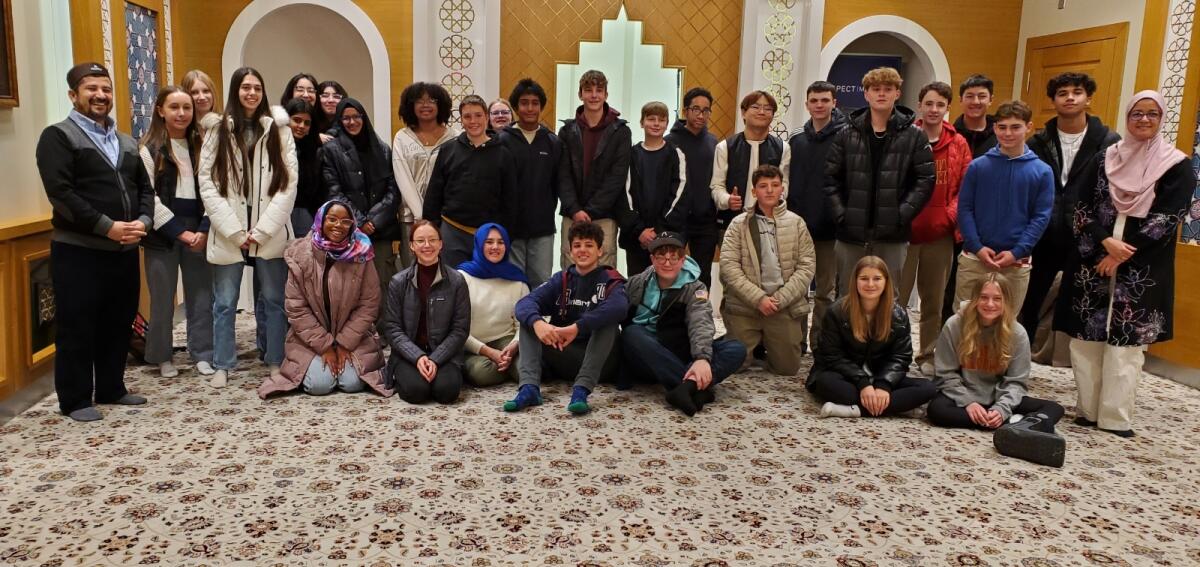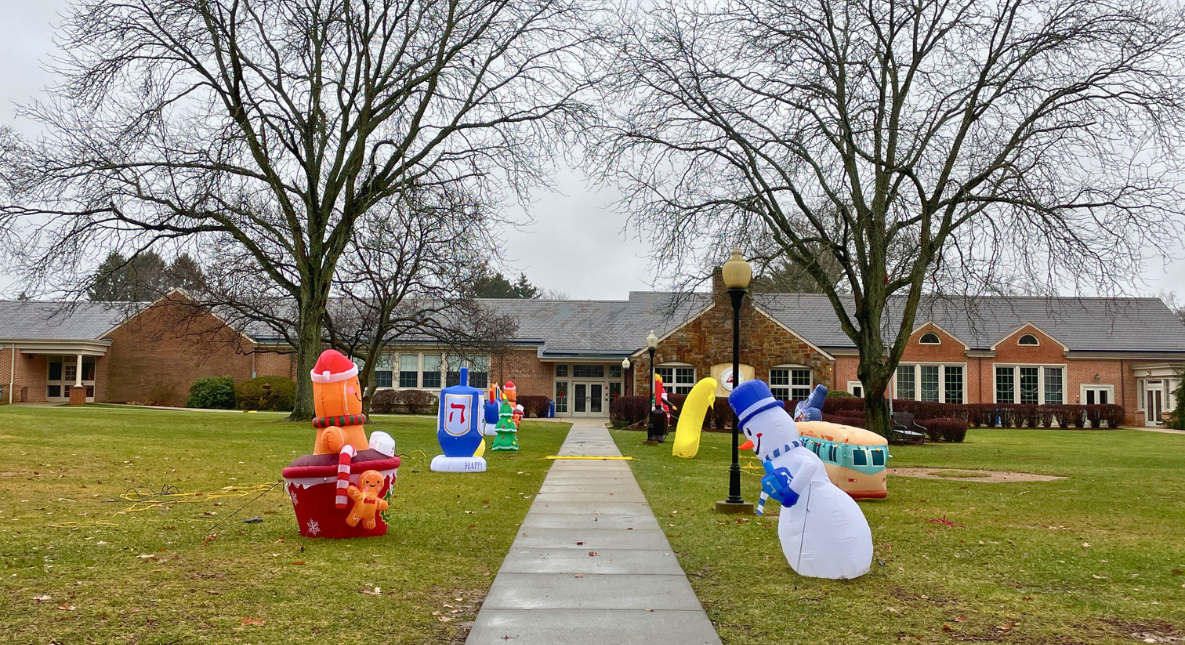Becoming & Belonging: Middle School Identity Chapel
What was your experience of becoming and belonging in Middle School? What do you wish your classmates and teachers knew about you in those years? What would you tell your sixth-grade self? These are the questions we asked Upper School students Avi Singh ’20 and Favor Ufondu ’22 to reflect on in their meditations offered at Middle School Chapel on Wednesday, January 15.
This powerful chapel is part of an ongoing exploration of identity at the Middle School, which students have explored both in grade-level activities with our Director of Community and Inclusion Mrs. Karen Washington and advisory circles dedicated to this topic.
As I said to the Middle School that day, becoming and belonging are each a critical part of human experience, especially in adolescence, and yet sometimes these experiences seem to conflict. We are each in the process of discovering and becoming our unique selves, and yet we want to belong and fit in with those around us, making us wish we could be more like everyone else. What we hope for and build together at Moravian Academy is a school community where everyone is celebrated for who they are and who they are becoming, where everyone feels the radical welcome of belonging, and where we give each other the space and encouragement we need to evolve and grow.
We invite you to listen and read Avi and Favor's speeches shared during chapel below. Both students are lifers at Moravian Academy and their words are challenging and inspiring.
Avi Singh '20
In his speech, Avi, a practicing Sikh, spoke about the turban he wears as part of his religious expression, and how he first became aware of his "otherness." As Avi grew up at Moravian Academy, he went from trying to hide his cultural identity to intense pride in his family tradition.
Read his full speech below:
“Avi wears a hat that kinda looks like there is a ball underneath. I asked him about it and he said it was culture. I don’t know what that means, but I didn’t ask.” - the diary of one of my kindergarten classmates.
Since a young age, I have been hyper-aware of my identity as a Sikh. The first day that I left the familiarity of my house to enter the uncertain world, my fellow wide-eyed five year olds bombarded me with questions regarding the "ball on my head." Of course, I had rehearsed for this; my parents had prepared me with answers that explained Sikhism as thoroughly as possible in five-year-old terms. Although the questions were never meant to be offensive in nature, they (the questions) were the first time that I became aware of my "otherness."
Being different isn’t easy. People often say they like “uniqueness” and “diversity,” but I always just wanted to fit in. “Fitting in," however, is difficult when you look different from everyone else. I’ve been asked thousands of times: “Why do you wear a turban?” or “Why do you have long hair?”
In my younger years, my cultural identity was something that I would try to hide and ignore. I would often be bothered by people asking me these questions about my differences, and I would try my best to accommodate myself to be more similar to my peers. As I grew older, I began to realize that these accommodations would do me no good. No matter how hard I tried, I would never be like my classmates, but that was ok.
Sikhism is different than most religions. For better or worse, the first and last thing people notice about me is my turban. I come from a pretty open-minded family; at any point, if I wanted to cut my hair and stop wearing a turban it wouldn't be an issue. Nevertheless, like my father (and my grandfather before him), I continue to wear a turban every day. The reason behind this practice is not due to an undying devotion to some "God" that requires it of me, but rather, my turban represents something much more significant.
My turban reminds me of the duty that I have to represent Sikhism. The impression that I leave on people matters, and this idea has served as fiercely inspirational. Whether it was on the soccer field, at academic competitions, or through volunteer work, my everyday activities served as an opportunity to engage with society and possibly relieve people’s uneasiness regarding the “other.” At times of adversity, I can feel the responsibility of my community's reputation hanging over my head, and it empowers me to be the best that I can possibly be while motivating me to interact positively with the outside world. My turban is a constant reminder of my extraordinary heritage; it effectively serves as an overt rejection to the pressure to fully conform into American society while representing the intense pride I have developed for my own cultural traditions. Although it may have taken me a while to accept, my turban is emblematic of overcoming the struggle of uniqueness, and I choose to wear it every day like a crown that is representative of my royal individuality.
Favor Ufondu '22
Favor reflects on middle school as her “own personal Golden Age," where she experienced what she calls her “glow-up." She credits the “excessive effort” others put forth to get to know her as a catalyst for learning to love herself.
Read her full speech below:
As ready as everyone else was to migrate to the Merle-Smith campus, I wish I could come back here. The middle school experience ushered me into my own personal Golden Age. I experienced a “glow-up” much larger than I ever could have imagined. I’m not referring to my appearance, although I do like to tell myself that I had somewhat of a physical glow-up. No, I’m talking about the fact that I learned to accept my identity and use it to my advantage here. But let’s backtrack a little.
I’ve been here since pre-k. I’m gonna be completely honest with you guys, and maybe even a little bit vulnerable. Throughout lower school, I didn’t have many friends. Going into 6th grade, everyone knew me, nobody knew me. You could ask me who my friends were in sixth grade, and I wouldn’t be able to tell you because, as far as I’m concerned, I didn’t really have any. Ask the teachers I had in lower school and they’ll tell you that I was quiet. I kept to myself. I refused to put myself out there out of the fear of rejection.
I thought that I had no friends because I was different. I’d sit in class and I would look at my classmates. I’d look at their skin tone and I’d look down at mine and I’d ask myself why mine looked different. I’d ask myself why most of the people in my class didn’t look like me. I’d listen to the girls talk about their hair and about how it isn’t supposed to be oily. My hair is oily; it’s supposed to be like that. I asked myself why my hair was different. I asked myself what was wrong with me. I remember Black History Month being my least favorite time of the school year because whenever we learned about slavery or the Civil Rights Movement, every pair of eyes in the room would slowly turn to look at me, which is ironic because my family didn’t come here until the 1980s, after the Civil Rights Movement. My face would go red; I’d look at the floor and avoid the gazes of everyone else, desperately waiting for it to be over.
I asked myself so many questions. “What’s wrong with me? What can I do to be more like them? Because maybe if I’m a little more like them and a little less like myself, things will be easier. Maybe if I’m more like them, I’ll have friends. Maybe if I’m more like them, people will love me. Maybe if I’m more like them, I’ll love myself.” It got to the point where I’d pray and pray that God take away this melanin, take away the frizz–––just take it all away–––and then get disappointed each morning when I woke up and saw that I was still black and that I still had an afro on top of my head. Once I realized that there was nothing I could do to make myself more like them–––to change who I was–––I decided that the best course of action was to put up walls, and that’s exactly what I did.
It wasn’t until towards the end of sixth grade that I met people that put in excessive effort to get to know me, people who took the time to break down the walls I’d put up. They helped me realize that there was nothing wrong with me. There is nothing wrong with me. The only thing I did wrong was asking myself what was wrong with me. I was asking the wrong questions. How were people supposed to love me if I didn’t know how to love myself? How were people supposed to like me if I hated myself for being different? How were people supposed to reach out and make a connection with me if I put myself in this corner and hid from them? These imaginary barriers that I set up did nothing but stop me from reaching my full potential. Coming to that realization is what initiated my glow up. That is what ushered me into my own Golden Age.
I’m gonna share something with you guys that took me way too long to figure out. Make no mistake–––I may be a minority, but there is absolutely nothing minor about me. My melanin is something to be celebrated, not ashamed of. I identify as a strong, black woman.
I came back here with the hope of catalyzing your glow ups. If you take away nothing from anything I just said, hear me now. There is nothing wrong with you. You belong here. You are an invaluable part of this community, so don’t be afraid to find your identity. And as you’re learning to embrace your own identity, don’t forget to help others find theirs.
Look for more Upper School student reflections on this topic to be offered in Middle School Chapel in February and March.


 myMA
myMA



.png)







